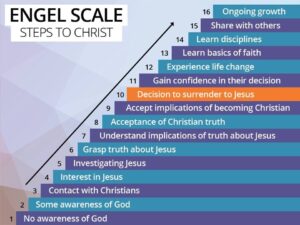I was recently challenged by a well-meaning children’s minister on my bent towards Family Ministry and more specifically of the effectual results of a Gospel Centric home vs Children’s Church unto salvation for children. The reason for said challenge came from this particular minister’s personal experience of not being raised in a Christian or even a semi-moral home. Their subsequent years were seeped in ungodly cultures and it wasn’t until later in life they experienced the gospel unto salvation. As a result of their experience, they deemed the home to be irrelevant in the salvific faith of a child and that children’s church would, or to phrase that a little better, should be more effectual in reaching children with the gospel.
I have a number of responses to this thought.
First of all, in the simplest of definitions of the phrase “means of grace” one finds the root of the definition to be: “to denote those institutions ordained by God to be the ordinary channels of grace to the souls of men.” [1] It is broadened to include initially, the Word, Prayer and Sacraments (although Sacraments would not be considered a means of grace unto salvation because those sacraments are reserved for the born-again believer) and further expanded to include additional vehicles such as “hearing the gospel, reading the Word, meditation, self-examination, Christian conversation, etc.[2] Whether or not one realizes it the family is the first institution created by  God for the purpose of filling the earth with His people. As such the Gospel-Centric family following through with the Scriptural mandate to model Christ, teach, and disciple their children would be (not should be) the most effective means to bring children into a saving relationship with Christ. This thought is widely supported in scripture in such passages as Genesis 18, Deuteronomy 6, Deuteronomy 11, Psalms 78, Psalms 145, Malachi 2, Acts 2, Ephesians 6, Colossians 3, and countless more.
God for the purpose of filling the earth with His people. As such the Gospel-Centric family following through with the Scriptural mandate to model Christ, teach, and disciple their children would be (not should be) the most effective means to bring children into a saving relationship with Christ. This thought is widely supported in scripture in such passages as Genesis 18, Deuteronomy 6, Deuteronomy 11, Psalms 78, Psalms 145, Malachi 2, Acts 2, Ephesians 6, Colossians 3, and countless more.
Secondly one would, upon a thorough examination of scripture find no reference at all to children’s church or any such specific institution, apart from the family, for the evangelization or discipleship of children. Much could be said here about where and how we got to children’s church and whether it is applicable or even whether we view scripture as prescriptive or merely descriptive when it comes to topics such as these. I point out that our theology must never elevate means and methods or cultural, organizational or even philosophical thoughts above the clear teaching of scripture or even lack thereof. If scripture is silent on a means of church activities such as children’s church it does not necessarily make that means right or wrong from a prescriptive viewpoint but this elevation of church activities above the plane of family worship to me would be a mistake. One is clearly scriptural and the other is an area scripture is silent on. This does not mean I believe children’s church is wholly wrong and should be expunged from the church, on the contrary, I teach in children’s church weekly. In the historical account, one can find “Temple school” as probably the best example found for teaching children outside of the family unit as a whole being taught together. This didn’t come about fully until the second temple period around 75BC in Judah when Rabbi Simon ben-Sheṭaḥ instituted compulsory elementary education for boys aged 6–16[3]. This is a counteractive posture to keep the education of Jewish children in the hands of the Jewish people and was likely a response to Greek philosophical schools were by philosophers such as Plato (circ ± 400BC) taught the best way to change cultural norms was to remove the children from the homes of parents to be taught communally. This compulsory education does not accurately correlate to children’s church although it can be seen as a forerunner to the thought. Probably a better forerunner to our modern children’s church would be the development of “Sunday School” in 1780, with Robert Raikes in Gloucester, England[4] and its embracement into church life as a regular part of the church structure. Some might even suggest that Sunday School is the sole reason they are Christians today.[5]
While children’s church has moved into significant prominence in the church in the 19th and 20th centuries (and continues into the 21st century as well) most realize it is but a small piece to the evangelization and discipleship of children. Dick Gruber, Professor of Children and Family Studies at the University of Valley Forge in Phoenixville, Pennsylvania puts it this way: “If the church is to be an agent of change in the lives of children, it must provide atmosphere and opportunity for children to intuitively generate positive spiritual insights. This can begin to happen in the traditional Sunday school or children’s church. But it cannot be limited to the one to three hours a child spends in the church building each week. The church must work with parents, reaching into the life and the home of the child in order to have lasting impact.”[6] Simply put, in my opinion, the family must be the primary means of salvific grace towards a child, supported by the church, not replaced by it. The Gospel-centered family unit then is the best incubator of a child’s heart towards the saving work of Christ.
The third response I would have would be a right understanding of prevenient grace and an understanding of the Engel scale. A James F. Engel back in the 1970’s began to look at the church’s results from evangelism and methods of presenting the gospel. In 1975 Engel published a book entitled “What’s Gone Wrong With The Harvest?” and in that book he presented a broader understanding of evangelism and conversion. Engel took the completion of conversion, what I call the pressure to “close the deal” out of the evangelistic engagement. Engel presented a scale on which all of humanity somewhere resides with the new birth centric to either end of the scale. On the furthest from God we find man with minimal or no acknowledgment of a supreme being (God) who is moved up the scale to the centric position of the new birth and then further on the scale into sanctification and the Christian life.

The Engel scale can be seen as a help in understanding prevenient grace as it recognizes the Holy Spirits’ work in drawing all men unto Himself.[7] Prevenient Grace is the grace extended through the work of the Holy Spirit upon human hearts whereby people are enabled to respond to God’s offer of salvation presented in the gospel.[8] It is this grace that moves a child towards salvation. In the Engel scale and prevenient grace, I would present a contrast to say that a child raised in a Gospel-Centric home will be much further up the scale towards the new birth than a child whose sole encounter with Holy Spirit is found in a Sunday morning Children’s church. As parents continue to live the Gospel in their homes, engage in worship and invite Holy Spirit to permeate their homes and lives so that the fallow soil of child’s heart becomes right for the Gospel to germinate into salvation. The last thing I would say here is that prevenient grace, the drawing of Holy Spirit is not by any means confined to the home but is at work in all spheres. This is no discount to those whom have come to Christ outside a Gospel-Centric home, whether a children’s church, Sunday service or on a street evangelism crusade. If I had to choose whether or not children came to children’s church or were being raised up in a Gospel-Centric home I would choose the home every single time.
Fortunately, we get to partner with our families to reach children through discipling families into becoming Gospel-Centric, Holy Spirit presence hosting homes AND we get to minister to those same children in a children’s church context.
[1] Easton, M. G. (1893). In Easton’s Bible dictionary. New York: Harper & Brothers.
[2] Easton, M. G. (1893). In Easton’s Bible dictionary. New York: Harper & Brothers.
[3] Wiseman, D. J. (1996). In the Old Testament. In D. R. W. Wood, I. H. Marshall, A. R. Millard, & J. I. Packer (Eds.), New Bible dictionary (3rd ed., p. 1067). Leicester, England; Downers Grove, IL: InterVarsity Press.
[4] Klaus, B. (1988). Our Sunday Schools—Spirit Powered. In S. Lee (Ed.), The Holy Spirit in Christian Education (p. 23). Springfield, MO: Gospel Publishing House.
[5] Klaus, B. (1988). Our Sunday Schools—Spirit Powered. In S. Lee (Ed.), The Holy Spirit in Christian Education (p. 24). Springfield, MO: Gospel Publishing House.
[6] Gruber, D. (2017). Foundations of Children’s Evangelism: How to Lead Kids to Christ (pp. 61–62). Springfield, MO: Logion Press.
[7] The New King James Version. (1982). (Ro 2:4) (John 12:32). Nashville: Thomas Nelson.
[8] Hernando, J. D. (2012). Prevenient Grace. In Dictionary of Hermeneutics: A Concise Guide to Terms, Names, Methods, and Expressions (Revised edition, p. 167). Springfield, MO: Gospel Publishing House.

